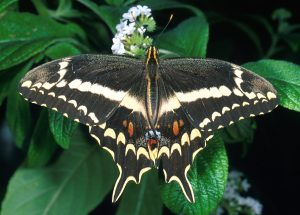Dr. Jaret Daniels on saving butterflies and the impact of the Disney Conservation Fund

Environmental Sustainability & Nature
April 28, 2023
Dr. Jaret Daniels says that like many other scientists, his interest in the natural world began at a very young age. He remembers spotting a caterpillar spinning a cocoon on a maple tree in his grandfather’s yard when he was just five years old and becoming enthralled by the giant moth that would eventually emerge from it.
“That totally sold me on butterflies and moths as like the coolest things ever,” he explains.
Now, Daniels is a professor at the University of Florida and curator at the Florida Museum of Natural History’s McGuire Center for Lepidoptera & Biodiversity, the largest global research center for the study of butterflies and moths.
Much of Daniels’ work has revolved around the Schaus’ swallowtail, a rare and still-endangered butterfly native to southern Florida. Over the last century, the population of this species has dwindled due to environmental changes like rapid urbanization and increasingly destructive hurricanes.
In 2012, a survey of the Schaus’ swallowtail population was only able to identify four adult butterflies remaining in the wild, a result Daniels describes as having been, “a red flag warning that, hey, this organism could be really going extinct.”
Along with his team, Daniels brought the Schaus’ swallowtail into captive breeding at the University of Florida in order to eventually release more and more specimens and strengthen the size of the wild population.

“Since that time, the numbers have ticked up significantly to a high of about 1,700 individuals,” Daniels says. “I think it has a very cautiously optimistic trajectory within the state of Florida and it’s a beautiful butterfly, it would be a shame if we lost that as part of our natural heritage.”
According to Daniels, receiving support from the Disney Conservation Fund grants has been instrumental in sustaining this vital, long-term work.
“It’s really fundamentally changed how we do conservation because conservation doesn’t happen overnight,” he explains. “It’s not a race, it’s a marathon and so you have to be in it for the long term. And having that depth and vision that Disney has with the funding provided has enabled us to really take our conservation work to the next level.”
As for the Schaus’ swallowtail and all other endangered species, Daniels says their futures depend on a concerted effort by us all.
“Going out, connecting to nature, understanding what is around you and what could be lost, and knowing that each of us has a role to play in ensuring that those species, even if they’re common today, we want them to be common for the next generation, for our children to enjoy,” he says. “But that all comes down to us.”
To learn more about the Disney Conservation Fund visit: www.disney.com/conservation.
Image credit (top): Jaret Daniels
Image credit (middle): Ryan Fessenden, University of Florida
